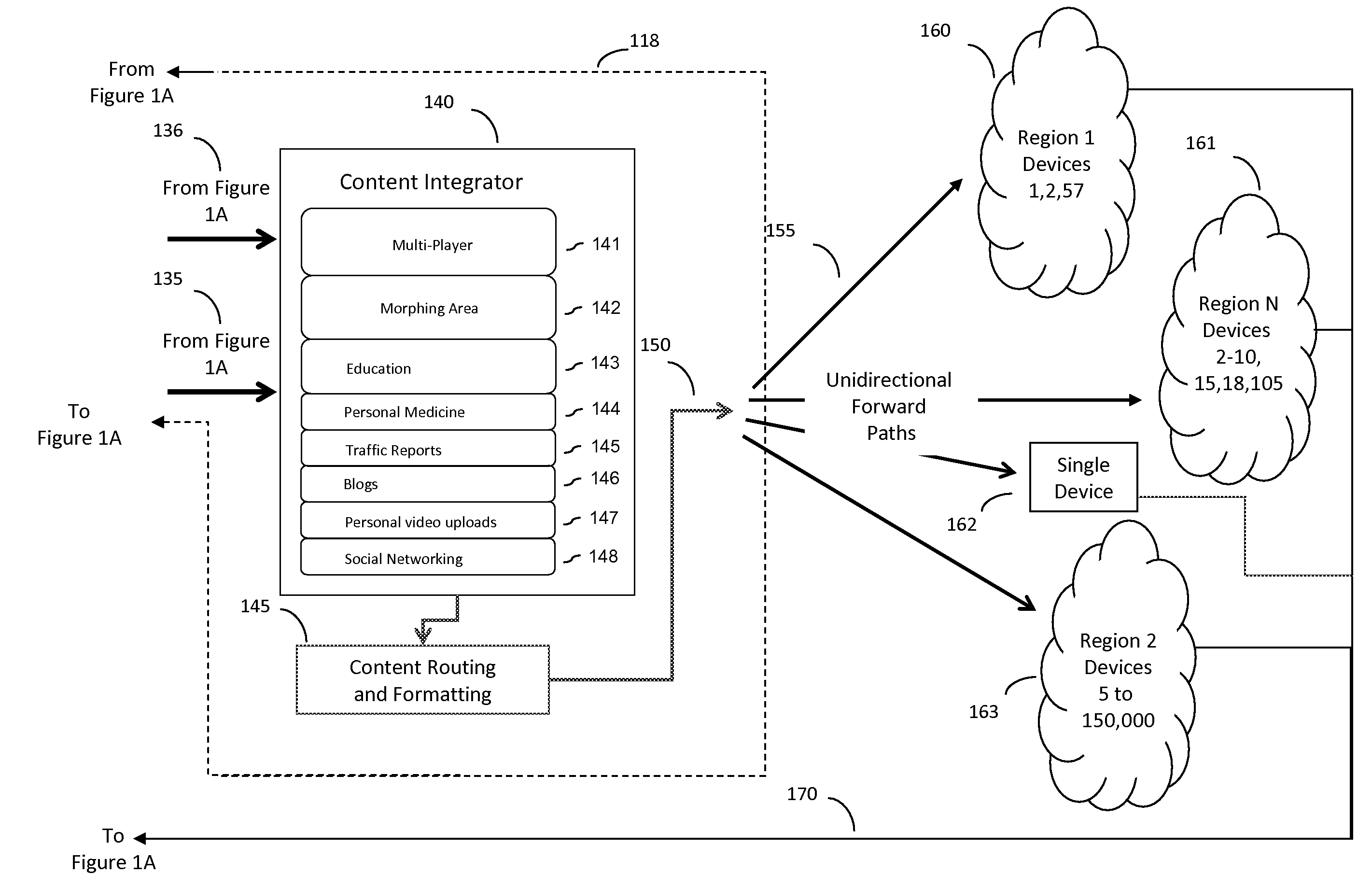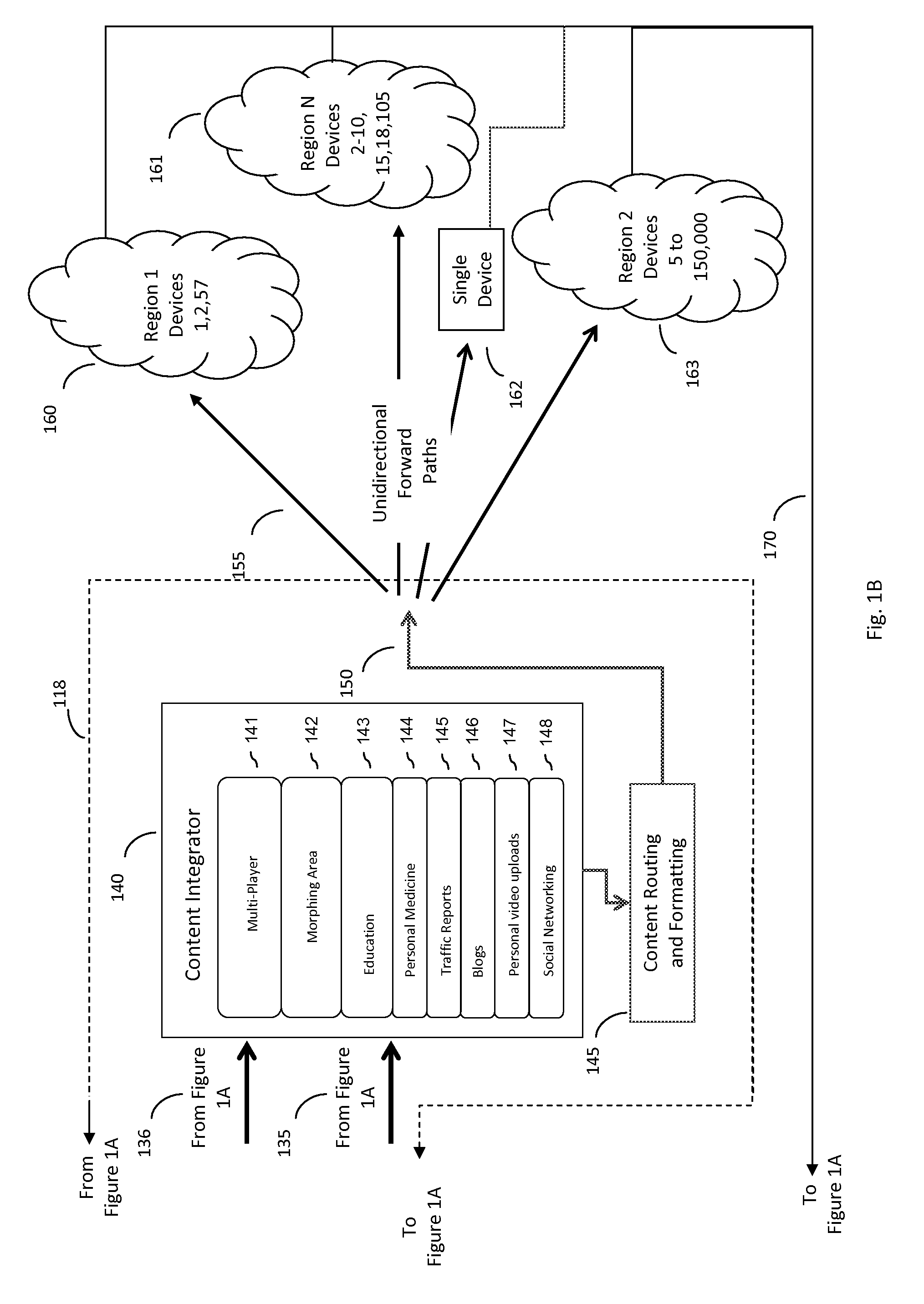[0014]The Forward Path Multi-Media Management System aggregates the reverse path feedback from the end
user device or devices and then processes this feedback data in context with the streamed forward path content. For example, if the application is a
multiplayer game, the Forward Path Multi-Media Management System receives the end user's reverse path feedback data which defines how their avatar or in-game virtual person should react or behave at a given point within the game. This feedback is sent to the Forward Path Multi-Media Management System via wired or wireless means. The Forward Path Multi-Media Management System, in this gaming example, aggregates and delivers the “combined feedback” of all the connected end users for that moment in time to the gaming
software application. The gaming
software application then modifies its streamed forward path content according to the latest “combined feedback”. The
wireless multicast network then delivers the latest video frames or sequence of successive game image frames of the game session (to include sound) to the participating end users based on the “combined feedback”. The
wireless multicast can be delivery targeted to regionally or locally grouped end user sub-populations to enhance the overall network efficiency. This process repeats in a continuous fashion, with continuous N+1 events of “combined feedback” delivered to the
software application, which in turn modifies the streamed forward path content.
[0016]End users in the Forward Path Multi-Media Management System can be grouped via location or region, together with personal attributes such as demographic, socio-graphic, or psychographic interests as it relates to a given multicasted content
stream. The
pairing of physical location groupings with personal interest attributes enables new and novel telecommunication services with the attendant
advantage of extremely efficient delivery. The wireless communication network's capacity utilization, both in terms of assets and spectrum, is very high.
[0020]Personal video uploads now have direct interaction from end users who can comment on a given video, add to the video (edit or modify it), or insert their own video that is context relevant to the existing video being streamed on the forward path. Public safety applications are another area where this telecommunication architecture excels. On congested urban highways, end users provide via a reverse path
feedback loop their GPS location, speed, and
traffic flow trend data to the Forward Path Multi-Media Management System. This data can be autonomous, sent
machine-to-
machine, or end user initiated. The Forward Path Multi-Media Management System aggregates the sub-
population data, creates a
traffic flow map for that moment in time, and re-delivers this
traffic flow map to the then connected
population of end users in a given
multicast region via a shared forward path channel (thereby dramatically enhancing efficiency). In this manner, all of the motorists know the traffic situation in real-time. The
system could even have intelligence to select alternate routings, measure how many autos take the alternate
route, see if the alternate
route's efficiency has changed, and then suggest a new alternate
route or routes.
[0021]Another public safety application involves the measurement of and changing
impact region of a physical phenomenon, such as a bio-
hazard,
chemical hazard, or terrorist event. For example, a
train carrying tanker cars of
chlorine derails as it is leaving a chemical facility and the tanks of
chlorine leak gas within the area of production facility, but a city is downwind of the growing plume. Pre-installed sensors at the
chemical production facility
relay, via the wired or wireless reverse path, the level of airborne
chlorine contamination in a real-time fashion; and the Forward Path Multi-Media Management System aggregates and processes this
data stream and sends out a map of the
contamination plume via a forward path
wireless multicast to all the workers at the production facility. The map of the plume's extent is updated in real-time as the plume spreads. Chemical facility personnel are now better protected and have better information to properly respond to the accident. As the plume spreads to the nearby city, and if ordinary citizen
cell phones were equipped with sensors to detect and report the level of
contamination of an airborne
hazardous substance, the plume would continue to be mapped and reported back via multicast. The technology to incorporate sensors into wireless devices is readily available. Most important, these plume map reports would be sent to public safety personnel and ordinary citizens, although each group might receive a different multicast, based on their needs. In particular, for the citizen population, an evacuation order is sent via multicast to include the evacuation directive and roads to take. The potential deadly
impact of the accident is greatly minimized; and timely information on the plume's direction, strength, and size dramatically improves actions taken during the emergency. Since the map of the plume is multicasted, the cellular, WiFi,
WiMax,
MediaFLO, or DVB-H network is not overcome with emergency related point-to-point telecommunication traffic, since cellular networks are not designed to
handle enormous spikes in
traffic volume associated with an emergency or
natural disaster event.
[0022]The Forward Path Multi-Media
Management system solves a complex problem resident in existing telecommunication architectures by combining reverse path feedback with forward path multicasting in numerous novel ways to achieve high
delivery efficiency, high subscriber targeting, and continuous content modification ensuring high relevancy.
 Login to View More
Login to View More  Login to View More
Login to View More 


